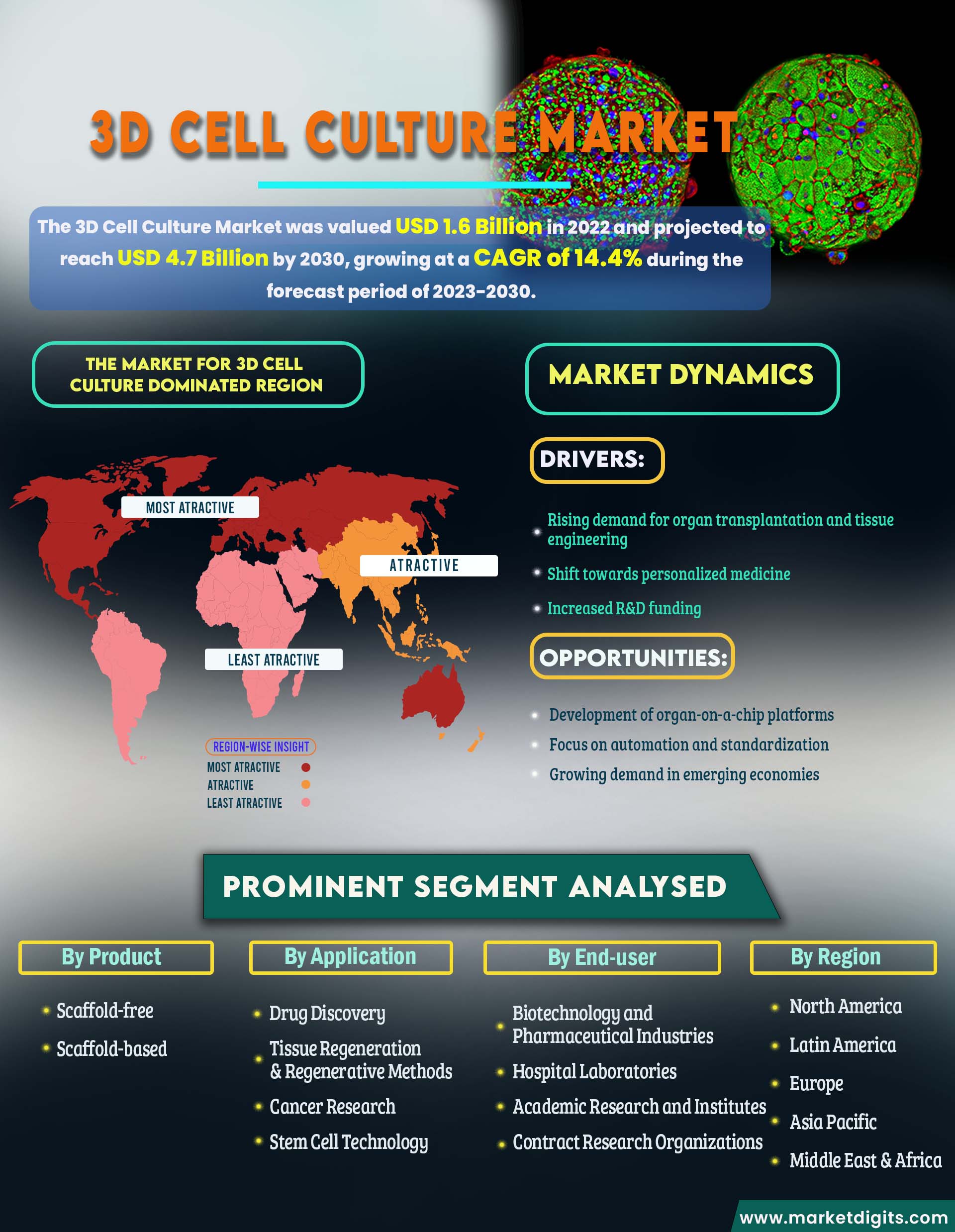- Home
- Healthcare
-
3D Cell Culture Market

3D Cell Culture Market By Product (Scaffold-free and Scaffold-based), By Application (Drug Discovery, Tissue Regeneration, Cancer Research, Stem Cell Technology and Others), By End User (Biotechnology and Pharmaceutical Industries, Academic Research and Institutes and Contract Research Organizations) and Region - Partner & Customer Ecosystem (Product Services, Proposition & Key Features) Competitive Index & Regional Footprints by MarketDigits - Forecast 2024-2032
Industry : Healthcare | Pages : 194 Pages | Published On : May 2024
Market Overview
3D cell culture creates an environment where cells can grow and interact with surrounding extracellular frameworks in three dimensions, in contrast to the conventional 2D cell cultures where cells grow in a flat monolayer on a plate. It can be cultivated within supporting scaffolds like hydrogels and inert matrices, enabling growth in all directions. Utilizing scaffold-free methods, such as low-adhesion plates, micropatterned surfaces, and hanging drops, allows cells to self-assemble into clusters or spheroids. Implementation within microchip chambers facilitates the flow of liquid to transport and distribute nutrients or chemicals throughout the cells.
3D Cell Culture Market Size

| Report | Details |
|---|---|
| Market Size Value | USD 1.6 billion in 2022 |
| Market Size Value | USD 4.7 billion by 2030 |
| CAGR | CAGR of 14.4% |
| Forecast Period | 2024-2032 |
| Base Year | 2023 |
| Historic Data | 2020 |
| Segments Covered | Product, Application, End User |
| Geographics Covered | North America, Europe, Asia Pacific, and RoW |
This approach more accurately mirrors the actual microenvironment in which cells reside in tissues compared to 2D cell culture. The market's growth is attributed to increasing efforts to develop alternatives to animal-based testing and the availability of funding programs for research. Additionally, ongoing research and development activities by biopharmaceutical companies for drug development and discovery, along with a focus on adopting 3D cell cultures in cancer research, are anticipated to drive market growth. While animal models are commonly used in cellular-based studies to understand various diseases, they come with drawbacks such as a lack of response accuracy and variations in responses among different species. To address these issues, various government organizations are actively promoting alternative methods for drug development.
Major vendors in the global 3D Cell Culture market are 3D Biotek LLC, Advanced Biomatrix Inc., Avantor, Inc., BiomimX SRL, CN Bio Innovations Ltd, Corning Incorporated, InSphero AG, Lena Biosciences, Lonza Group Ltd., Merck KGaA, MIMETAS BV, PromoCell GmbH, REPROCELL Inc., Tecan Trading AG, Thermo Fisher Scientific Inc. and Others.
Increasing focus on precision medicine
The anticipated growth of the 3D cell culture market is expected to be bolstered by the increasing emphasis on precision medicine within the projected timeframe. The use of 3D cultures, particularly organoid cultures, introduces opportunities for developing personalized therapies customized for each patient. For example, in addressing the variations in cancer cells resulting from mutations among different individuals, the capability to cultivate small tumor explants from individual patients and assess their response to treatment has been employed in numerous studies, leading to the identification of novel drugs. In the field of respiratory medicine, researchers cultivated organoids from two cystic fibrosis patients to assess their responsiveness to the drug ivacaftor. Encouragingly, the organoid cultures accurately predicted the subsequent positive responses observed in the patients. Similar findings have been noted in cancer research, where patient-derived pancreatic cancer tumoroids demonstrated a correlation in drug sensitivity with the original tumors. Given that organoid cultures can be derived from adult tissues, this approach holds significant promise for tailoring treatment approaches on an individual basis for various diseases. Consequently, this is poised to contribute to the growth of the 3D cell culture market during the forecast period.
Market Dynamics
Drivers:
- Rising demand for organ transplantation and tissue engineering
- Shift towards personalized medicine
- Increased R&D funding
Opportunities:
- Development of organ-on-a-chip platforms
- Focus on automation and standardization
- Growing demand in emerging economies
Increasing collaborations & partnerships among key players
The expected rise in collaborations and partnerships among diverse organizations for the progression of 3D cell cultures is poised to generate growth opportunities for the market in the coming years. A notable example is the June 2020 collaboration between Lonza and the Swedish company CELLINK, aimed at providing a comprehensive solution for 3-dimensional (3D) bioprinting. The objective of this partnership is to enhance and streamline complete 3D cell culture workflows, ultimately optimizing and expanding access to advanced 3D cell culture technologies.
Another significant collaboration occurred in April 2022 when Manchester BIOGEL and Cell Guidance Systems Ltd. partnered to introduce PODS-PeptiGels. This innovative kit combines the benefits of two established cell culture technologies—synthetic peptide hydrogels known as PeptiGels and a collection of constant-release growth factors called PODS. The collaboration's purpose is to present a reliable and flexible platform for 3D cell culture by leveraging the unique features of both technologies. The resulting PODS-PeptiGels kit offers researchers a reproducible and highly adaptable environment for conducting their 3D cell culture experiments. Consequently, this collaborative effort is expected to expedite the market's growth in the years ahead.
The Market for 3D Cell Culture is Dominated by North America.
In 2022, North America, led by the United States, holds a dominant position in the overall 3D cell culture market. The United States, with its focused research and development initiatives, has been a significant contributor to the market's growth. Considerable investments in 3D cell culture research have led to notable technological advancements in the country, reflected in the high number of American applicants featuring prominently among major patent applicants in the domain. These American applicants often develop their technologies not only within the United States but also extend their research efforts into Asia. The bioengineering sector in the United States has witnessed substantial investments in recent years, with a notable portion dedicated to 3D cell culture research. According to the National Institute of Health, the total investment in various bioengineering technologies in 2020 amounted to USD 5,646, marking an increase from USD 5,091 in 2019. These investments have significantly contributed to the growth of the 3D cell culture market in the United States.
Furthermore, the increasing need to replicate intricate elements of human physiology, pathology, and medication reactions in vitro is driving the demand for 3D cell cultures. The region is expected to see a surge in demand for 3D cell cultures, particularly with the growing need for organ transplantation. According to the Canadian Institute for Health Information, there was a notable increase in transplant procedures in Canada in 2021, with a total of 3,014 procedures performed, marking a 42% increase since 2010. Considering these factors, the market in the North American region is anticipated to witness significant growth over the forecast period.
The Infant Formula Segments is anticipated to hold the Largest Market Share during the Forecast Period
Based on end-user, the market is segmented into biotechnology and pharmaceutical industries, hospital laboratories, academic research and institutes, and contract research organizations. In 2022, the biotechnology and pharmaceutical industries segment dominated with a substantial revenue share. The prevalence of 3D cell culture in this sector is attributed to its capacity to offer several notable advantages, presenting a more authentic representation of cell interactions, division, and morphology that closely mirrors the natural cellular environment. Consequently, gene expression and morphology in 3D cell culture systems more accurately mirror those found in the human body. A key advantage lies in the creation of environmental niches and microenvironments where cells encounter diverse levels of oxygen, nutrients, metabolites, and signaling molecules. This contrasts with 2D cell culture, where cells have uniform and unrestricted access to these factors. These distinctive features contribute to the growth of the biotechnology and pharmaceutical industries segment throughout the forecast period.
Segmentations Analysis of 3D Cell Culture Market: -
- By Product
- Scaffold-free
- Hanging Drop Microplates
- Spheroid Microplates with ULA coating
- Magnetic Levitation
- Scaffold-based
- Hydrogels
- Polymeric Scaffolds
- Micropatterned Surface Microplates
- Nanofiber Based Scaffolds
- Scaffold-free
- By Application
- Drug Discovery
- Tissue Regeneration & Regenerative Methods
- Cancer Research
- Stem Cell Technology
- Others
- By End User
- Biotechnology and Pharmaceutical Industries
- Hospital Laboratories
- Academic Research and Institutes
- Contract Research Organizations
- By Region
- North America
- US
- Canada
- Latin America
- Brazil
- Mexico
- Argentina
- Colombia
- Chile
- Peru
- Rest of Latin America
- Europe
- UK
- Germany
- France
- Italy
- Spain
- Russia
- BENELUX
- CIS & Russia
- Nordics
- Austria
- Poland
- Rest of Europe
- Asia Pacific
- China
- Japan
- India
- South Korea
- Thailand
- Indonesia
- Malaysia
- Vietnam
- Australia & New Zealand
- Rest of Asia Pacific
- Rest of the World
- Saudi Arabia
- UAE
- South Africa
- Nigeria
- Egypt
- Israel
- Turkey
- North America
Recent Developments
- July 2023, REPROCELL Inc. had formed a strategic partnership with Vernal Biosciences to provide scaled mRNA services for clinical and research applications in Japan. This collaboration aligns with REPROCELL's objective to bring advanced preclinical and clinical research solutions to the market.
- June 2023, Lonza has engaged in a strategic business collaboration with Vertex Pharmaceuticals Incorporated, with the goal of facilitating the production of Vertex’s array of fully differentiated insulin-producing investigational stem cell-derived islet cell therapies. This collaboration aims to expedite clinical trials for individuals diagnosed with Type 1 diabetes.
3D Cell Culture Market Report Gives Answers to Following Key Questions:
- What will be the 3D Cell Culture Market’s Trends & growth rate? What analysis has been done of the prices, sales, and volume of the top producers of 3D Cell Culture Market?
- What are the main forces behind worldwide 3D Cell Culture Market? Which companies dominate 3D Cell Culture Market?
- Which companies dominate 3D Cell Culture Market? Which business possibilities, dangers, and tactics did they embrace in the market?
- What are the global 3D Cell Culture industry's suppliers' opportunities and dangers in 3D Cell Culture Market?
- What is the 3D Cell Culture industry's regional sales, income, and pricing analysis? In the 3D Cell Culture Market, who are the distributors, traders, and resellers?
- What are the main geographic areas for various trades that are anticipated to have astounding expansion over the 3D Cell Culture Market?
- What are the main geographical areas for various industries that are anticipated to observe astounding expansion for 3D Cell Culture Market?
- What are the dominant revenue-generating regions for 3D Cell Culture Market, as well as regional growth trends?
- By the end of the forecast period, what will the market size and growth rate be?
- What are the main 3D Cell Culture Market trends that are influencing the market's expansion?
- Which key product categories dominate 3D Cell Culture Market? What is 3D Cell Culture Market’s main applications?
- In the coming years, which 3D Cell Culture Market technology will dominate the market?
Reason to purchase this 3D Cell Culture Market Report:
- Determine prospective investment areas based on a detailed trend analysis of the global 3D Cell Culture Market over the next years.
- Gain an in-depth understanding of the underlying factors driving demand for different 3D Cell Culture Market segments in the top spending countries across the world and identify the opportunities each offers.
- Strengthen your understanding of the market in terms of demand drivers, industry trends, and the latest technological developments, among others.
- Identify the major channels that are driving the global 3D Cell Culture Market, providing a clear picture of future opportunities that can be tapped, resulting in revenue expansion.
- Channelize resources by focusing on the ongoing programs that are being undertaken by the different countries within the global 3D Cell Culture Market.
- Make correct business decisions based on a thorough analysis of the total competitive landscape of the sector with detailed profiles of the top 3D Cell Culture Market providers worldwide, including information about their products, alliances, recent contract wins, and financial analysis wherever available.
TOC
Table and Figures
Methodology:
At MarketDigits, we take immense pride in our 360° Research Methodology, which serves as the cornerstone of our research process. It represents a rigorous and comprehensive approach that goes beyond traditional methods to provide a holistic understanding of industry dynamics.
This methodology is built upon the integration of all seven research methodologies developed by MarketDigits, a renowned global research and consulting firm. By leveraging the collective strength of these methodologies, we are able to deliver a 360° view of the challenges, trends, and issues impacting your industry.
The first step of our 360° Research Methodology™ involves conducting extensive primary research, which involves gathering first-hand information through interviews, surveys, and interactions with industry experts, key stakeholders, and market participants. This approach enables us to gather valuable insights and perspectives directly from the source.
Secondary research is another crucial component of our methodology. It involves a deep dive into various data sources, including industry reports, market databases, scholarly articles, and regulatory documents. This helps us gather a wide range of information, validate findings, and provide a comprehensive understanding of the industry landscape.
Furthermore, our methodology incorporates technology-based research techniques, such as data mining, text analytics, and predictive modelling, to uncover hidden patterns, correlations, and trends within the data. This data-driven approach enhances the accuracy and reliability of our analysis, enabling us to make informed and actionable recommendations.
In addition, our analysts bring their industry expertise and domain knowledge to bear on the research process. Their deep understanding of market dynamics, emerging trends, and future prospects allows for insightful interpretation of the data and identification of strategic opportunities.
To ensure the highest level of quality and reliability, our research process undergoes rigorous validation and verification. This includes cross-referencing and triangulation of data from multiple sources, as well as peer reviews and expert consultations.
The result of our 360° Research Methodology is a comprehensive and robust research report that empowers you to make well-informed business decisions. It provides a panoramic view of the industry landscape, helping you navigate challenges, seize opportunities, and stay ahead of the competition.
In summary, our 360° Research Methodology is designed to provide you with a deep understanding of your industry by integrating various research techniques, industry expertise, and data-driven analysis. It ensures that every business decision you make is based on a well-triangulated and comprehensive research experience.

• Product Planning Strategy
• New Product Stratergy
• Expanded Research Scope
• Comprehensive Research
• Strategic Consulting
• Provocative and pragmatic
• Accelerate Revenue & Growth
• Evaluate the competitive landscape
• Optimize your partner network
• Analyzing industries
• Mapping trends
• Strategizing growth
• Implementing plans
Covered Key Topics
Growth Opportunities
Market Growth Drivers
Leading Market Players
Company Market Share
Market Size and Growth Rate
Market Trend and Technological
Research Assistance
We will be happy to help you find what you need. Please call us or write to us:
+1 510-730-3200 (USA Number)
Email: sales@marketdigits.com







